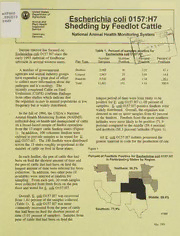Table Of ContentHistoric, Archive Document
Do not assume content reflects current
scientific knowledge, policies, or practices.
United States
Department of
— Escherichia coli 0157:H7
inspection Shedding by Feedlot Cattle _
Veterinary National Animal Health Monitoring System™ aes
oma a Ve \
Intense interest has focused on Table 1. Percent of samp\es positive for 4
Escherichia coli 0157:H7 since the Escherichicoal i O457:H7.
early 1993 outbreak of foodborne
Number Number Percents. Percent of
infection in several western states. ample PO E Yael Ositive _ Positive
A number of governmental Shortest 2,988 90 3.01 47.1
agencies and animal industry groups Longest 2,963 32 1.08 16.8
have expended a great deal of effort Random
5,930 _69 1.16 mo6. |
to collect more information about the =y oy)
11,881 191 1.61 100.0
pathogen and it’s ecology. The
recently completed Cattle on Feed
Evaluation (COFE) confirms findings
from other studies which indicate that — longest period of time were least likely to be
the organism occurs in animal populations at low positive for E. coli O157:H7 (1.08 percent of
frequency but is widely distributed. samples). E. coli 0157:H7-positive feedlots were
widely distributed. Overall, the organism was
In the fall of 1994, the USDA’s National detected in one or more samples from 63 percent
Animal Health Monitoring System (NAHMS) of the feedlots. Feedlots from the more southern
collected data on health and management of cattle latitudes were more likely to be positive (71.9
on a broad-based sample of feedlot operations percent) compared to the middle (59.4 percent)
from the 13 major cattle feeding states (Figure and northern (58.3 percent) latitudes (Figure 1).
1). In addition, 100 volunteer feedlots were
enlisted to provide samples to be tested for E. All E. coli O157:H7 isolates possessed the
coli 0157:H7. The 100 feedlots were distributed genetic material to code for the production of one
across the 13 states roughly proportional to the
number of cattle on feed in those states. Figure 1
In each feedlot, the pen of cattle that had Percent of Feedlots Positive for Escherichia coli 0157:H7
been on feed the shortest amount of time and in Participating States by Region
the pen of cattle that had been on feed the
longest amount of time were selected for feces
collection. In addition, two other pens (if
available) were selected at random for
sampling. From each pen, 30 swab samples
were collected from fresh feces on the pen
floor and tested for E. coli O157:H7.
Overall, E. coli O157:H7 was recovered
Middle: 59.4%
from 1.61 percent of the samples collected
(Table 1). E. coli O157:H7 was most
commonly recovered from the pens of cattle
Southern: 71.9%
that had been on feed the shortest period of
#2886
time (3.01 percent of samples). Samples from
pens of cattle that had been on feed the
May 1995
AMINO
1022400816 : ;
Or DOT OF tne toxms thought to be important in operations.” From these tentative associations,
the pathogenesis of human disease (Shiga-like targeted studies will define factors which
toxin 1 and Shiga-like toxin 2).! modulate shedding. Such studies may eventually
lead to strategies for decreasing the shedding of
These data would seem to indicate that the E. the organism.
coli 0157:H7 organism is widely distributed in
feedlot cattle populations, but the prevalence is
very low. These findings are similar to other NAHMS collaborators on the COFE included the
cattle populations that have been evaluated, such National Agricultural Statistics Service (USDA); State and
as dairy cattle and calves. Federal Veterinary Medical Officers; the National
Veterinary Services Laboratories (USDA:APHIS:VS); and
the Field Disease Investigation Unit, Washington State
The percent of samples positive for E. coli
University.
0157:H7 in a pen varied from none to 36.7
percent. On a feedlot basis, the percent of total Other information from the COFE is available on feedlot
samples positive for E. coli 0157:H7 varied from quality assurance measures, environmental monitoring,
0.0 to 10.0 percent. The variation in percent of injection practices, and vaccination practices. For more
samples positive per feedlot suggests that the information on these topics or the study in general contact:
agent may be amenable to reduction through
Centers for Epidemiology & Animal Health
management changes. The next phase of analysis
USDA:APHIS:VS, Attn. NAHMS
of these data will focus on associations between
555 South Howes, Suite 200
management practices (general and nutritional) Fort Collins, Colorado 80521
(970) 490-7800
and number of positive samples. An increased or
Internet: [email protected]
decreased likelihood of shedding of the organism
has been tentatively associated with a variety of
N182.595
management factors in studies of dairy
1 Three isolates not available to be probed for the genetic coding for toxin production.
2 Reports discussing these findings are available from the address shown above.

